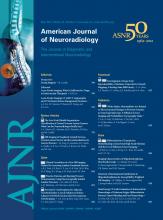Research ArticleFunctional
Open Access
Investigation of Long-Term Reproducibility of Intrinsic Connectivity Network Mapping: A Resting-State fMRI Study
Y.-h. Chou, L.P. Panych, C.C. Dickey, J.R. Petrella and N.-k. Chen
American Journal of Neuroradiology May 2012, 33 (5) 833-838; DOI: https://doi.org/10.3174/ajnr.A2894
Y.-h. Chou
L.P. Panych
C.C. Dickey
J.R. Petrella

References
- 1.↵
- Raichle ME,
- Mintun MA
- 2.↵
- Biswal B,
- Yetkin FZ,
- Haughton VM,
- et al
- 3.↵
- Cordes D,
- Haughton VM,
- Arfanakis K,
- et al
- 4.↵
- Lowe MJ,
- Mock BJ,
- Sorenson JA
- 5.↵
- Greicius MD,
- Krasnow B,
- Reiss AL,
- et al
- 6.↵
- Raichle ME,
- MacLeod AM,
- Snyder AZ,
- et al
- 7.↵
- Fox MD,
- Corbetta M,
- Snyder AZ,
- et al
- 8.↵
- Vincent JL,
- Kahn I,
- Snyder AZ,
- et al
- 9.↵
- 10.↵
- Greicius MD,
- Srivastava G,
- Reiss AL,
- et al
- 11.↵
- 12.↵
- Liao W,
- Zhang Z,
- Pan Z,
- et al
- 13.↵
- Luo C,
- Li Q,
- Lai Y,
- et al
- 14.↵
- Cherkassky VL,
- Kana RK,
- Keller TA,
- et al
- 15.↵
- Kennedy DP,
- Courchesne E
- 16.↵
- Liang M,
- Zhou Y,
- Jiang T,
- et al
- 17.↵
- Skudlarski P,
- Jagannathan K,
- Anderson K,
- et al
- 18.↵
- Amann M,
- Hirsch J,
- Gass A
- 19.↵
- Biswal BB,
- Mennes M,
- Zuo XN,
- et al
- 20.↵
- Damoiseaux JS,
- Rombouts SA,
- Barkhof F,
- et al
- 21.↵
- De Luca M,
- Beckmann CF,
- De Stefano N,
- et al
- 22.↵
- Honey CJ,
- Sporns O,
- Cammoun L,
- et al
- 23.↵
- Shehzad Z,
- Kelly AM,
- Reiss PT,
- et al
- 24.↵
- van de Ven VG,
- Formisano E,
- Prvulovic D,
- et al
- 25.↵
- Smith SM,
- Jenkinson M,
- Woolrich MW,
- et al
- 26.↵
- Petrella JR,
- Sheldon FC,
- Prince SE,
- et al
- 27.↵
- Ongür D,
- Lundy M,
- Greenhouse I,
- et al
- 28.↵
- Bluhm RL,
- Miller J,
- Lanius RA,
- et al
- 29.↵
- Fox MD,
- Snyder AZ,
- Vincent JL,
- et al
- 30.↵
- Fransson P
- 31.↵
- Uddin LQ,
- Clare Kelly AM,
- Biswal B,
- et al
- 32.↵
- 33.↵
- Zou Q,
- Long X,
- Zuo X,
- et al
- 34.↵
- Shrout PE,
- Fleiss JL
- 35.↵
- Landis JR,
- Koch GG
- 36.↵
- Gasparovic C,
- Bedrick EJ,
- Mayer AR,
- et al
- 37.↵
- Henry ME,
- Kaufman MJ,
- Lange N,
- et al
- 38.↵
- 39.↵
- Tzourio-Mazoyer N,
- Landeau B,
- Papathanassiou D,
- et al
- 40.↵
- Bassett DS,
- Bullmore E
- 41.↵
- Guye M,
- Bartolomei F,
- Ranjeva J-P
- 42.↵
- Sporns O,
- Zwi JD
- 43.↵
- 44.↵
- Cordes D,
- Haughton V,
- Carew JD,
- et al
- 45.↵
- Ferrarini L,
- Veer IM,
- Baerends E,
- et al
- 46.↵
- Chen NK,
- Chou YH,
- Song AW,
- et al
- 47.↵
- Van Dijk KR,
- Hedden T,
- Venkataraman A,
- et al
- 48.↵
- Hausmann M,
- Tegenthoff M,
- Sänger J,
- et al
- 49.↵
- Tian L,
- Wang J,
- Yan C,
- et al
- 50.↵
- Weis S,
- Hausmann M,
- Stoffers B,
- et al
In this issue
Advertisement
Y.-h. Chou, L.P. Panych, C.C. Dickey, J.R. Petrella, N.-k. Chen
Investigation of Long-Term Reproducibility of Intrinsic Connectivity Network Mapping: A Resting-State fMRI Study
American Journal of Neuroradiology May 2012, 33 (5) 833-838; DOI: 10.3174/ajnr.A2894
0 Responses
Jump to section
Related Articles
Cited By...
- The Role of Visual Experience in Individual Differences of Brain Connectivity
- No impact of functional connectivity of the motor system on the resting motor threshold: A replication study
- Tracking ongoing cognition in individuals using brief, whole-brain functional connectivity patterns
- Resting-State fMRI: A Review of Methods and Clinical Applications
- From the bridges of Konigsberg to the fields of Alzheimer: Connecting the dots
This article has not yet been cited by articles in journals that are participating in Crossref Cited-by Linking.
More in this TOC Section
Similar Articles
Advertisement











